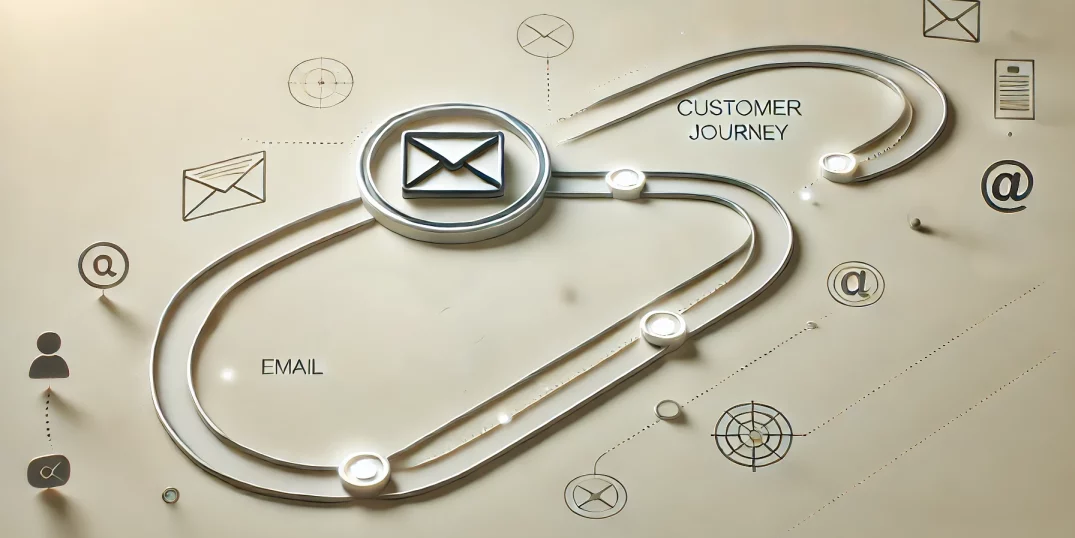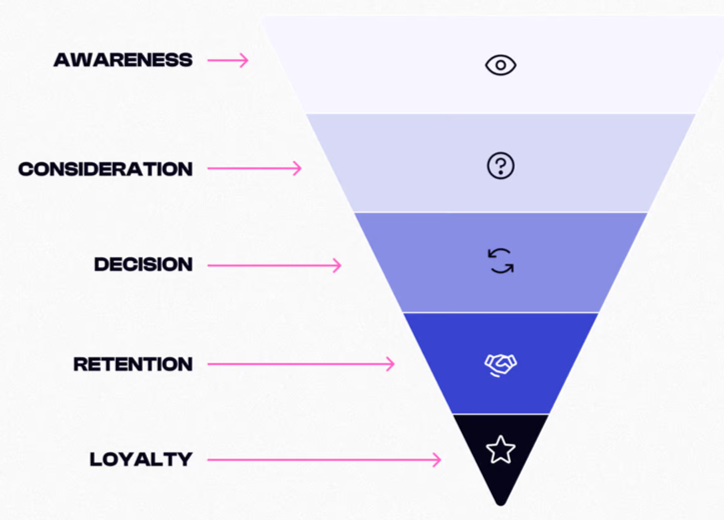- Home
- Fundamentals of Email Marketing
- The Complete Guide to Email Cu ...

✨ Key takeaways:
⭐ An email customer journey guides people with a series of campaigns.
⭐ Each stage of a customer journey needs timely, relevant emails to move customers forward.
⭐ Welcome series, how-tos, offers, and thank-you notes all support the journey.
⭐ Mapping the journey improves engagement, conversions, and retention.
⭐ Segmentation and automation make scaling easier and more effective.
If you started to read this article, the odds are high that you agree with our firm belief that email marketing is one of the most powerful tools for engaging customers. However, sending random emails won’t help you achieve your business goals. Instead, you need a reliable, structured approach; we call it a roadmap to guide your audience from awareness to advocacy. That’s where an email marketing customer journey comes in.
Creating an email marketing journey plan for customers is vital for any business to optimize its sales and marketing processes. According to Woopra, an online analytics and promotion agency, “Among high-performing teams, 88% say a customer journey strategy is critical to the success of their overall marketing.” As you can see, the number is rather convincing to take developing a working strategy for email marketing customer journey seriously.
This guide will walk you, stage by stage, through the process. We will also provide real-life examples and help you create an effective strategy to achieve your email marketing goals. The first thing would be finding an answer to the core question: What is a customer journey in marketing?
What Is an Email Customer Journey?
Here’s the answer: An email customer journey is a series of targeted emails sent to customers at different stages of their relationship with your brand. It’s a comprehensive, strategic way to generate leads, drive conversions, and build loyalty over time. Forget about sending one-off emails! After reading this article, you will understand how to create an automated sequence that aligns with customer behavior and needs.
Now, let’s look at the crucial stages of developing a proper email customer journey.
Key Stages of an Email Customer Journey
A. Awareness stage (Onboarding emails)
Purpose: Introduce your brand and create a first impression
At this stage, you aim to welcome new subscribers, introduce your brand, and provide essential information about your products or services. Yes, it is this simple!
Example emails:
Let’s look at three examples that create a path to your customer’s heart—and loyalty: welcoming customers, telling a brand story, and highlighting a product.
- Welcome series: A friendly introduction to your brand. Please make sure that you use personalization. You should start with a personalized statement, such as, “John, have you ever thought of a software solution that answers all your online accounting questions?”
- Brand story: Share your company’s mission and values. Consider this: “Our company has been developing reliable and efficient online accounting software products for over twenty years. We strongly believe that 100% customer satisfaction is our core value.”
- Product highlights: Showcase key features and benefits. How about this: “With our AI-based all-in-one solution, you will forget about importing bank statements manually!”
B. Consideration stage (Nurture emails)
Purpose: Educate potential customers and build trust
Here, you nurture leads by providing valuable information that helps your customers make informed decisions.
Example emails:
- Educational content: Consider developing blog posts, how-to guides, and insights from industry experts.
- Product comparisons: You can highlight differences between your product and competitors. For example, you can mention that your software is AI-based, which makes transactions match financial records automatically.
- Testimonials: Showcase success stories from satisfied customers. Yes, just get at least a couple of real-life stories from your customers to build trust. Adding their pictures would strengthen your communication.
C. Decision stage (Conversion-focused emails)
Purpose: Drive the customer toward making a purchase
At this stage, your customer is very close to purchasing. Your emails should remove any remaining doubts and encourage immediate action. Here’s a tip: be persistent!
Example emails:
- Cart abandonment emails: Remind customers about their incomplete purchase. Consider this: “Hey Mary, we believe you’ve got unfinished business in your cart. Let’s check it!”
- Limited-time offers: Create urgency with discounts or promotions. You can enable a countdown timer for your limited-time offer to the customer.
- Free trials: Encourage sign-ups by offering a no-risk trial—“Sign up now and enjoy a 30-day free trial!”
D. Post-purchase stage (Retention & engagement)
Purpose: Enhance satisfaction and encourage repeat purchases
Congrats! You crossed the Rubicon as the customer bought your product. But keep on going, don’t stop! After a purchase, your chain of emails should focus on customer satisfaction and continued engagement.
Example emails:
- Thank-you emails: Express appreciation for your customer’s purchase using personalization—“Thank you for your buy, Donald!”
- Product guides: Provide tips on how to use the product effectively—“After installing our software, please activate all features for maximum performance.”
- Feedback requests: Encourage customers to share their thoughts—“Feel free to tell the world what you think about our product!”
E. Loyalty/Advocacy stage (Upsell and referral emails)
Purpose: Build long-term loyalty and generate referrals
Don’t you think happy customers can become your brand’s faithful advocates? At this stage, after the purchase, emails should focus on maintaining loyalty and encouraging referrals.
Example emails:
There are several proven ways in email marketing to build brand loyalty in the long run and encourage referrals.
- Loyalty program updates: Inform customers about rewards and benefits. We recommend you develop a comprehensive loyalty program to make it customer-friendly—“Join our loyalty program and become eligible for our Merry Christmas promotion for devoted customers!”
- Exclusive offers: Provide VIP deals for your permanent customers. For example, you can offer seductive discounts and limited-time deals for your faithful clients.
- Referral invitations: Encourage customers to refer friends in exchange for incentives—“Earn up to $100 for inviting a friend!”

Benefits of Mapping an Email Customer Journey
The rule of thumb is that a proper email customer journey must have tangible benefits. Let’s look at what you can gain if everything is implemented correctly:
- Better engagement: Sending relevant content at the right time increases customer attention.
- Higher conversions: A higher conversion rate leads to more purchasing activity as it guides customers toward making a buy.
- Stronger retention: Due to a proper marketing journey, the customer feels more comfortable, which engages them to come back.
- Improved personalization: It provides tailored experiences based on behavior. Personalization is the king of email marketing. You must always engage it to develop trusted and direct communication with the customer. According to Noble Desktop, New York City’s leading coding and design school, personalization is crucial for online businesses in developing deeper connections with customers.
How to Create an Effective Email Customer Journey
Let’s sum up your email customer roadmap in four simple steps:
- Define customer stages: First, you must identify key moments in the customer journey. It is about collecting information about your customers’ preferences, behaviors, and demographics. You must track their purchase history, determine their preferred communication channels, and understand their pain points, if any.
- Segment your audience: Once you understand your target audience structure, send personalized content based on their interests and behavior, using specific email marketing tools.
- Automate your emails: Use email marketing tools to develop sequences and trigger the customer’s interest. Automation is the key to building a sustainable customer relationship.
- Test and optimize: After completion of your email marketing customer journey, you should continuously analyze performance and make improvements if needed.
Real-Life Examples of Successful Email Journeys
Let’s now look at a couple of real-life customer journey email examples. You will learn from the experiences of an e-commerce brand and a SaaS company.
Example 1: An e-commerce brand
De Beers’ engagement ring campaign
De Beers has been known for creating beautiful diamond jewelry since 1888. It is a truly multinational corporation with headquarters in London. De Beers is about diamond mining, exploitation, manufacturing, retail, and trading worldwide.
When De Beers launched its new e-commerce offer, which allowed customers to buy individual diamonds online from anywhere in the world, they wanted to optimize their experience specifically for engagement ring shoppers.
For that purpose, De Beers decided to undertake its customer journey analysis. They analyzed jewelry customers vs. bridal customers looking for engagement rings. In the process, De Beers understood that users searching for engagement rings were browsing more and spending more time on the pages. As a result of the comprehensive user behavior research, they launched personalized appointment deals for customers browsing bridal jewelry. This smart move led to a 27% increase in in-store appointment requests from bridal jewelry pages!
Example 2: A SaaS company
TurboTax’s product launch strategy
TurboTax is a leading U.S.-based software for preparing income tax returns. When TurboTax introduced its Personal Pro product, it developed a comprehensive customer journey map to understand the user experience, all the way from website entry to tax filing completion. It was necessary because the new product aimed to connect consumers with professional accountants online, which the company had never done before. Personal Pro was an innovative tool that allowed consumers to have their taxes prepared by a professional.
First, the company invested a lot in data research, customer surveys, and key conversations with tax professionals to understand how the soon-to-be-launched product fits into the lives of its customers.
After a thorough analysis of customer actions, ideas, and feelings at each stage, TurboTax was able to identify pain points and optimize the process. The outcome? A smoother and more satisfactory user experience. The Personal Pro software has become a huge hit, reaching plenty of final consumers across the United States and Canada.
As you can figure out, these examples illustrate how businesses can effectively map and optimize their email customer journeys to enhance user experience and drive engagement. Even if your business is comparatively small, you are highly recommended to use these examples as sources of inspiration to develop your email customer journey experience.
To Sum Up
Great job, you are almost there! We hope you have concluded that a compelling email customer journey depends on your audience receiving the right messages at the right time. The key to a successful roadmap in your customer journey marketing is to define each stage (look at four simple steps above) and craft targeted emails. If properly implemented, you will drive customer engagement, boost conversions, and establish long-term loyalty to your brand.
To write your success story tomorrow, begin implementing these strategies today to see tangible results in your customer journey efforts!



